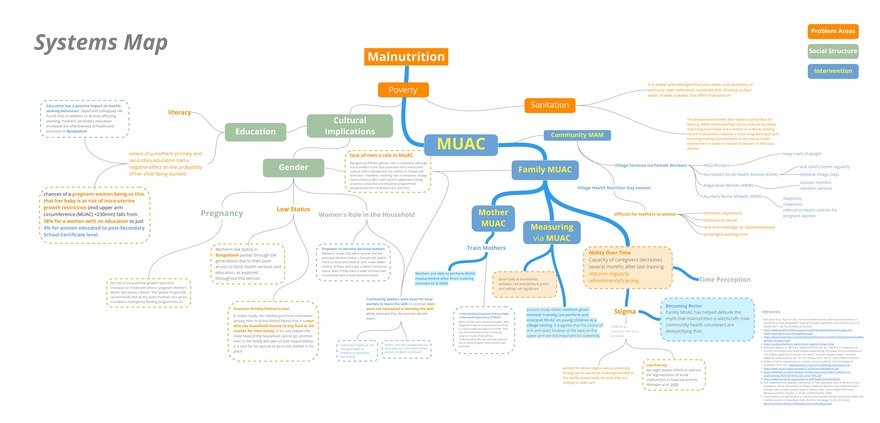
- Student
MUAC-Scrape: Measuring for Malnutrition
A team from Harvard University's Master in Design Engineering Program (MDE) collaborated with IRC's Airbel Impact Lab to re-design the MUAC-tape. The original MUAC -tape (Middle Upper Arm Circumference) is a tool distributed to caretakers in countries that require humanitarian assistance. The tape measures the circumference of a child's arm (6 to 59 months old) and helps determine if the child has acute malnutrition (or wasted :low weight-for-height where a child is thin for his/her height but not necessarily short). The team's research discovered that of the 49.5 million children with malnutrition (MAM & SAM) in 2018, only 40% were diagnosed, and 55% of those diagnosed would visit clinics. However, 75% of the children will complete the treatment cycle once children visit the clinic. Further research from the Airbel Impact Lab showed that of the 90% of caregivers trained to use the MUAC-tape, only 20% have visited a health clinic, and a significant number have only used the tape once. The team concluded that the main issues are the significant gap between those with malnutrition and those who get diagnosed, and the gap between those who get diagnosed and those who visit the clinic. Hence, the team decided that the new design should encourage regular screening and reliably notify the urgency of the child's state of malnutrition.
The team from MDE designed the MUAC-Scrape. The new design retains a similar shape and mechanism as the old design. This is because the mechanism of the original MUAC-tape is already well taught, and the simple shape allows the product to retain a competitive production cost. However, key features were added or improved. This includes the ability to mark the tape with the current measurement of the child, and different colored rows so that the caretaker can mark the measurement for each child in the household. When caretakers receive the tape, it is reminded that red areas being revealed while measuring the child is still an indication of being at high-risk of malnutrition. Furthermore, since caretakers can now mark the tape, caretakers should also check changes in the child's measurements, and a drop in the measurement is a sign for alarm.
The MUAC-Scrape is made with latex-based scratch paper. This is because research showed that the diagnostic elements of the tape became a stigma for caretakers and discouraged use of it. Hence, a non-stigma inducing design is laminated over the diagnostic, so that results are not revealed until caretakers use the tape, and those with healthy children are not discouraged from testing their children again.
For the next steps, the team will begin prototyping batch quantities and testing.
Kozuki N, Van Boetzelaer E, Tesfai C, Zhou A. Severe acute malnutrition treatment delivered by low-literate community health workers in South Sudan: A prospective cohort study. J Glob Health. 2020 Jun;10(1):010421. doi: 10.7189/jogh.10.010421. PMID: 32566163; PMCID: PMC7295452.
Design Team
Harvard University Master in Design Engineering / IRC Airbel Impact Lab
Team: Jenn Yoolim Kim / Jae-Hyun An / Jiwon Woo / Hana Yamaki
Advisors: Carla Lopez / Britt Titus
Professors: Jock Herron / Lubov Greenwood
A key feature included in the new MUAC-Scrape is a method for parents to monitor changes in the child. The original MUAC tape does not allow the caregiver to mark the circumference of the child's arm. By allowing caretakers to mark their child's diagnosis, the caregiver can notice when a child is getting thinner. Even if the child is in the green zone of the diagnostic, a thinning child should still be alarming, and the caretaker should take the child to the clinic.
The tape is made with scratch paper because it remains a cost-effective option and is easy for caregivers to use. Since the average family in Mali has six children, the team divided the front and back of the tape into six scratchable strips in different colors. Each strip tracks the diagnosis of each child. The tip of MUAC-Scrape scratches off the latex laminate and reveals the child's current diagnosis. Above the tip, there is a subtle depiction of the two colors (red/green) that caregivers should look out for.
The original MUAC-tape had a few design elements that the team considered unnecessary and quickly removed. This includes the yellow area of the tape because it raised uncertainty and caused mothers to visit the clinic without a clear indication if the child was malnourished or not. The team also removed the numbers, script, and tick markers because many caregivers are illiterate. Finally, to increase accessibility, the hole at the top of the MUAC tape was increased from 5 mm to 20 mm to hang from nails, pegs, and branches.
The user experience feels familiar to the caregiver, and they will quickly adjust to the new design. Like before, the caregiver still measures the child's arm in the same location and wraps the tape around the arm, but the caregiver will now see several new features as described in the step-by-step guide below.
1. Measure halfway down the upper arm and place the tape between the arm and the body.
2. Wrap the head of the tape around the arm.
3. Tuck the tail under the head and through the measuring hole.
4. Use the tip of the tail to scratch the tape and reveal the symbol underneath.
4a. MUAC-Scrape has a scratcher that marks the measurement.
5. Depending on the symbol beneath, determine whether the child is malnourished or not.
-
o1Favorite This
-
QComment
K
{Welcome
Create a Core77 Account
Already have an account? Sign In
By creating a Core77 account you confirm that you accept the Terms of Use
K
Reset Password
Please enter your email and we will send an email to reset your password.






